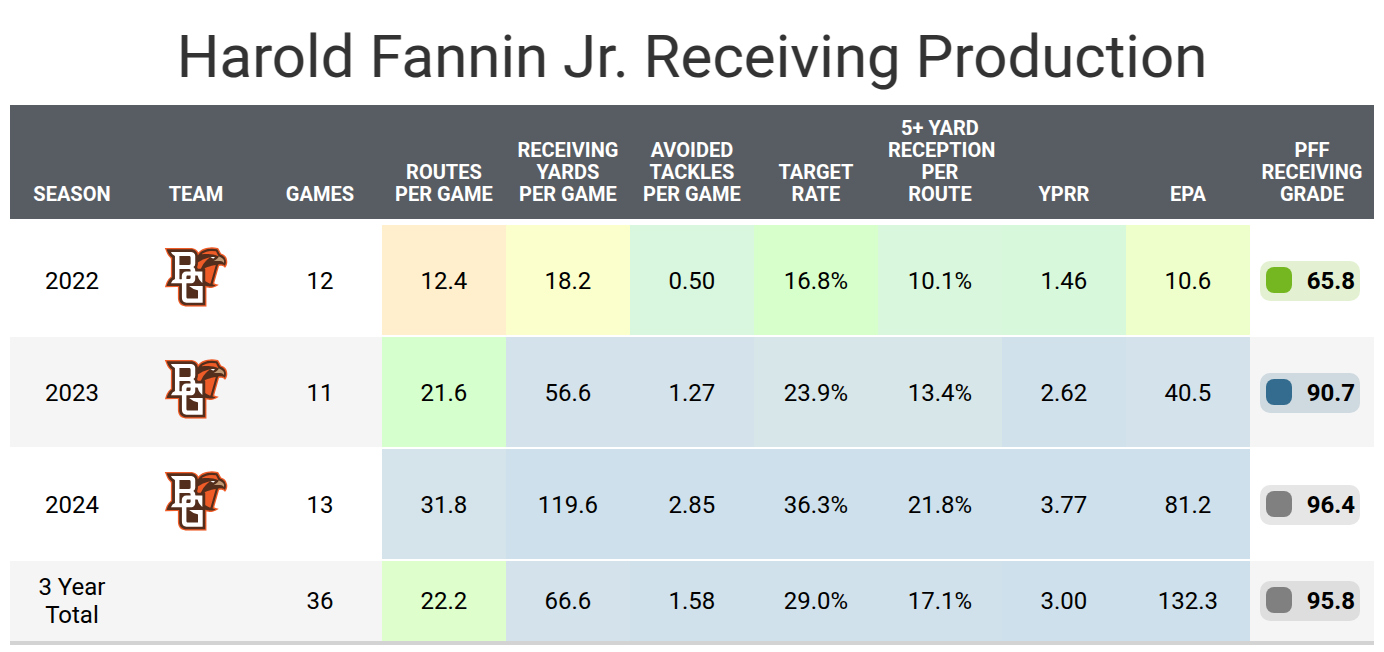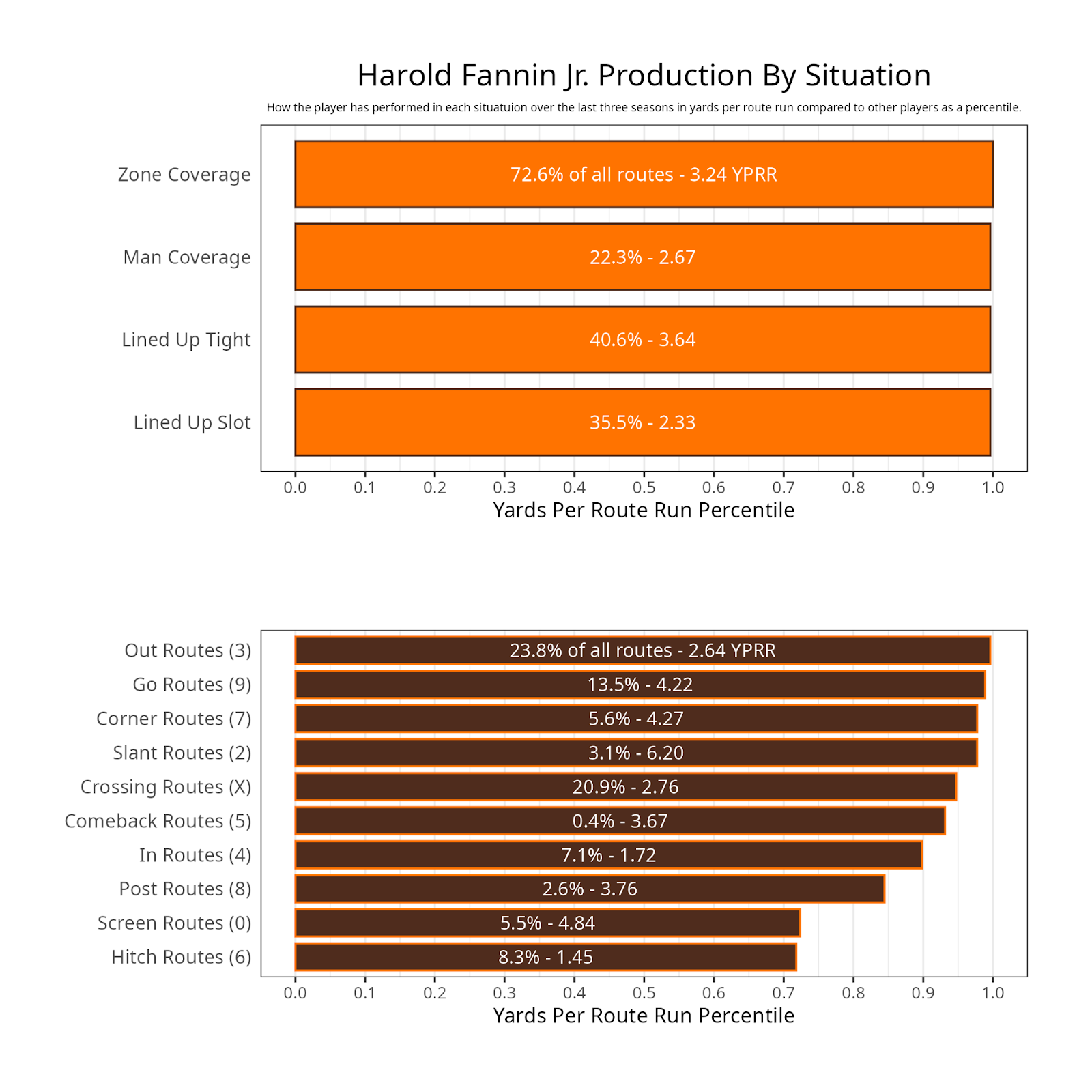- Harold Fannin Jr. put up unheard-of numbers: Fannin averaged 3.77 yards per route run with nearly three avoided tackles per game last season with Bowling Green.
- His level of competition makes him harder to evaluate: Most of his success occurred against MAC opponents, but he still produced elite numbers in his limited games against Power-Four opponents.
- 2025 NFL Draft season is here: Try PFF's best-in-class Mock Draft Simulator and learn about 2025's top prospects while trading and drafting for your favorite NFL team.
Estimated Reading Time: 5 minutes

PFF’s fantasy football player profile series delivers the most in-depth fantasy football analysis available for the 2025 season.
Using PFF’s exclusive data, we evaluate player performance, competition for touches and how teammates and coaching staffs will impact each player's fantasy football outlook.
Last updated: 7:15 a.m. Friday, April 18
Click here for more draft tools:
NFL Draft Big Board | Mock Draft Simulator | NCAA Premium Stats
2025 PFF Draft Guide | Mock Draft Hub | Prospect Data Profiles
Draft Position Rankings
Player performance
Fannin was a rotational player for Bowling Green in 2022 and then posted a dominant performance as a starter in 2023. He could have easily transferred to a Power-Four school as a starting tight end, but he remained out of loyalty. In 2024, Fannin put up ridiculous numbers, primarily against opponents outside the Power Four. He caught 12 passes for 193 yards against Old Dominion and made 10 receptions for 171 yards against Kent State.
However, Fannin also put up dominant games against Texas A&M and Penn State, finishing with a combined 19 receptions for 282 yards and two touchdowns against them. They were two of the top three games against a Power-Four opponent in terms of receiving yards by a tight end last season. Both were one-score games throughout, and Fannin earned over 100 yards by the start of the fourth quarter in each game.
While Fannin’s 4.71-second 40-yard dash at the combine was relatively average for a tight end, his average max speed ranks in the top 10th percentile of tight ends since 2016, according to PFF's tracking data. Over 40% of his routes have been crossing routes or go routes. For the most part, that’s all he’s needed, but in the NFL, he will need a more diverse route tree.


Projected role
Fannin measured at 6-foot-3 and 241 pounds at the combine, which puts him on the smaller side at tight end. The only tight ends at that height or shorter and that weight or lighter with 25 or more targets last season were Chigoziem Okonkwo, Noah Gray, Dalton Kincaid, Evan Engram and Taysom Hill. Engram had the highest snap rate at 71.5%, followed by Okonkwo at 60.8%. Fannin’s size suggests he may only play in typical passing situations and miss out on some snaps in two tight end sets in favor of bigger blockers. This can be particularly a problem in the end zone. While he had a ridiculous 50% end-zone target share in 2024, all five tight ends mentioned struggled with receiving touchdowns last season.
Despite his size, he has a higher chance of playing a high percentage of snaps relative to some of the tight ends in this class. He received a 75.2 run-blocking grade last season and has plenty of experience as an in-line tight end. Our draft guide mentioned, “his blocking snaps are good enough to keep him inline as a TE2 or a wingback on occasion.” Fannin has a better chance of being an every-down tight end than others his size. Even if his blocking helps him stay on the field for 5-10% more snaps than other receiving tight ends, that is a positive.

Most mocked teams
Chicago Bears
Cole Kmet posted the second-lowest receiving grade of his career at 58.6 last season. Chicago would save $8.4 million in cap space if he’s released in 2026. Fannin could sit behind Kmet for a year after the Bears spend a second-day pick on Fannin, and then Fannin can take over in 2026.
Los Angeles Rams
Tyler Higbee will be 33 years old by the end of the 2025 season. Fannin is the youngest of the tight ends expected to be picked on the first or second day of the draft, so it makes sense for him to land on a team where he might sit for a year.
New Orleans Saints
The Saints re-signed Juwan Johnson to a three-year contract, but he’s not the long-term option at the position. This would not be the best option for his fantasy value, as he would likely need to sit out two seasons, and the quarterback situation is very uncertain two years from now.
Bottom line
Fannin had an incredibly productive college career, but the MAC has no recent history of turning its tight ends into NFL starters, let alone fantasy starters. His landing spot will go a long way in determining if he has fantasy value this season, but he will be an intriguing dynasty option regardless of his new home.
Footnotes
- Statistics in tables and charts were generally chosen based on their ability to predict future fantasy performance on a per-game or per-opportunity basis or for their ability to describe the player relative to others at the same position.
- “Opportunities” are defined as passing dropbacks, rushing attempts and receiving routes run.
- Numbers are either by season or based on the past three years. For rookies, only college numbers are included. Only NFL numbers are included for non-rookies, even if they played in college during the previous three years.
- Because college competition is easier than NFL competition, most rookies will likely see a decline from their historic numbers.
- Only FBS data is considered for college players and comparisons.
- Kneel-downs are removed from rushing data to provide cleaner quarterback rushing rate statistics.
- The colors for all tables in this article range from blue (good or high) to red (bad or low).
- All percentiles or colors compare the given player to other players with a high sample of opportunities. Generally, the cut-off is one-third of the possible opportunities in the sample. If the player in question doesn’t have enough opportunities, they are still compared, even though they could look good or bad based on the small sample size, which might not be as predictive.
- Information on utilization classifications and their importance can be found here for running backs, wide receivers and tight ends.



 © 2025 PFF - all rights reserved.
© 2025 PFF - all rights reserved.